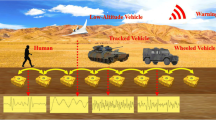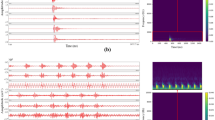Abstract
Microseismic monitoring technology is widely used in tunnel and coal mine safety production. For signals generated by ultra-weak microseismic events, traditional sensors encounter limitations in terms of detection sensitivity. Given the complex engineering environment, automatic multi-classification of microseismic data is highly required. In this study, we use acceleration sensors to collect signals and combine the improved Visual Geometry Group with a convolutional block attention module to obtain a new network structure, termed CNN_BAM, for automatic classification and identification of microseismic events. We use the dataset collected from the Hanjiang-to-Weihe River Diversion Project to train and validate the network model. Results show that the CNN_BAM model exhibits good feature extraction ability, achieving a recognition accuracy of 99.29%, surpassing all its counterparts. The stability and accuracy of the classification algorithm improve remarkably. In addition, through fine-tuning and migration to the Pan II Mine Project, the network demonstrates reliable generalization performance. This outcome reflects its adaptability across different projects and promising application prospects.
Similar content being viewed by others
References
Wang, Q.H., Zhang, Y.T., Xie, Z., Zhao, Y.W., Zhang, C., Sun, C., Wu, G.H., 2022, The Advancement and Challenges of Seismic Techniques for Ultra-Deep Carbonate Reservoir Exploitation in the Tarim Basin of Northwestern China: Energies, 15, 7653.
Nan, L. I., En-Yuan, W., & Mao-Chen, G. E., 2017, Microseismic Monitoring Technique and Its Applications at Coal Mines: Present Status and Future prospects: Journal of China Coal Society, 42, 83–96.
Li, J., Yu, B. S., Tian, Y. K., Kang, H. X., Wang, Y. F., and Zhou, H., 2020, Effect analysis of borehole microseismic monitoring technology on shale gas fracturing in western hubei: Applied Geophysics, 17, 764–775.
Tang, Shibin, J. Wang, and C. Tang., 2021., Identification of microseismic events in rock engineering by a convolutional neural network combined with an attention mechanism: Rock Mechanics and Rock Engineering, 54(1), 1–23.
Zhang, C., Jin, G., Liu, C., Li, S., Xue, J., Cheng, R., Wnag, X., Zheng, X., 2021, Prediction of rockbursts in a typical island working face of a coal mine through microseismic monitoring technology: Tunnelling and Underground Space Technology, 113, 103972.
Liu, L., Song, W., Zeng, C., and Yang, X., 2021, Microseismic event detection and classification based on convolutional neural network: Journal of Applied Geophysics, 192(6), 104380.
Xu, S., Zhang, C., Chen, Z., Li, Y., and Liu, J., 2021, Accurate identification of microseismic waveforms based on an improved neural network model: Journal of Applied Geophysics, 190, 104343.
Zhu, M., Wang, L., Liu, X., Zhao, J., and Peng, P., 2018, Accurate identification of microseismic p- and s-phase arrivals using the multi-step AIC algorithm: Journal of Applied Geophysics, 150, 284–293.
Angus, D. A., Aljaafari, A., Usher, P., and Verdon, J. P., 2014, Seismic waveforms and velocity model heterogeneity: towards a full-waveform microseismic location algorithm: Journal of Applied Geophysics, 111, 228–233.
A, P. B. Q., A, P. G., A, Y. C., and B, M. U., 2015, Detection and classification of seismic events with progressive multi-channel correlation and hidden markov models: Computers & Geosciences, 83, 110–119.
Dong, L., Wesseloo, J., Potvin, Y., and Li, X., 2016, Discrimination of mine seismic events and blasts using the fisher classifier, naive bayesian classifier and logistic regression: Rock Mechanics and Rock Engineering, 49(1), 183–211.
Kuyuk, H. S., Yildirim, E., Dogan, E., and Horasan, G., 2011, An unsupervised learning algorithm: application to the discrimination of seismic events and quarry blasts in the vicinity of Istanbul: Natural hazards and earth system sciences, 11(1), 93–100.
Dong, Long-Jun, Wesseloo, Johan, Potvin, and Yves, et al., 2016, Discriminant models of blasts and seismic events in mine seismology: International Journal of Rock Mechanics & Mining Sciences, 86, 282–291.
Zhou, Y., & Wu, G., 2020, Unsupervised machine learning for waveform extraction in microseismic denoising: Journal of Applied Geophysics, 173, 103879.
Iqbal N, Liu E, McClellan J, Al-Shuhail A, Kaka S, Zerguine A., 2018, Detection and denoising of microseismic events using time–frequency representation and tensor decomposition: IEEE Access, 6, 22993–23006.
Chen., Y., 2016, Dip-separated structural filtering using seislet transform and adaptive empirical mode decomposition based dip filter: Geophysical Journal International, 206(1), 457–469.
Xing Li, Z., Lian Yue, C., Yan, C. et al., 2022, Microseismic signal denoising by combining variational mode decomposition with permutation entropy: Applied Geophysics, 19, 65–80.
Zhang, XL., Jia, RS., Lu, XM. et al., 2018, Identification of blasting vibration and coal-rock fracturing microseismic signals: Applied Geophysics, 15, 280–289.
Lin, B., Wei, X., and Junjie, Z., 2019, Automatic recognition and classification of multi-channel microseismic waveform based on DCNN and SVM: Computers & geosciences, 123, 111–120.
Peng, P., He, Z., Wang, L., and Jiang, Y., 2020, Automatic classification of microseismic records in underground mining: a deep learning approach: IEEE Access, 8, 17863–17876.
Lin, B. I., Wei, X. I. E., Junjie, Z. H. A. O., and Hui, Z. H. A. O., 2018, Automatic classification of multi-channel microseismic waveform based on DCNN-SPP: Journal of Applied Geophysics, 159, 446–452.
Girshick, R., Donahue, J., Darrell, T., and Malik, J., 2014, Rich feature hierarchies for accurate object detection and semantic segmentation: IEEE Computer Society, 580–587.
Wang, J., Tang, S., 2022, Novel Transfer Learning Framework for Microseismic Event Recognition Between Multiple Monitoring Projects: Rock Mechanics and Rock Engineering, 55, 3563–3582.
Yilun, Z., Jiaxuan, L., Yihan, D., Zhichao, Y., Tianyue, H., and Chuan, H., 2022, Phase arrival picking for bridging multi-source downhole microseismic data using deep transfer learning: Journal of Geophysics and Engineering, 19(2), 178–191.
Jaderberg, M., Simonyan, K., Zisserman, A., and Kavukcuoglu, K., 2015, Spatial transformer networks: MIT Press.
Simonyan, K., & Zisserman, A., 2014, Very deep convolutional networks for large-scale image recognition: Computer Science.
He, K., Zhang, X., Ren, S., & Sun, J., 2016, Deep Residual Learning for Image Recognition: IEEE Conference on Computer Vision and Pattern Recognition IEEE.
Krizhevsky, A., Sutskever, I., & Hinton, G., 2012, Imagenet classification with deep convolutional neural networks: Advances in neural information processing systems, 25(2).
Cortes, C., & Vapnik, V., 2009, Support-vector networks: Chemical Biology & Drug Design, 297(3), 273–297.
Statistics, L. B., & Breiman, L., 2001, Random forests: Machine Learning, 5–32.
Kading C, Rodner E, Freytag A, Denzler J., 2017, Fine-tuning deep neural networks in continuous learning scenarios: Lecture Notes in Artificial Intelligence, 10118, 588–605.
Acknowledgments
This work was supported by the Key Research and Development Plan of Anhui Province (202104a05020059) and the Excellent Scientific Research and Innovation Team of Anhui Province (2022AH010003). Partial financial support from Hefei Comprehensive National Science Center is highly appreciated.
Author information
Authors and Affiliations
Corresponding author
Ethics declarations
The authors declare that they have no known competing financial interests or personal relationships that could have appeared to influence the work reported in this paper.
Additional information
Shu Jin is currently working toward her MS degree in optical engineering in the School of Physics and optoelectronic engineering, Anhui University, Hefei, China. She is a master’s candidate directed by Prof. Shenglai Zhen.
Shenglai Zhen is a professor at the School of Physics and Optoelectronic Engineering at Anhui University, Hefei, China. He received an MS degree in optics in 2003 and a PhD degree in electromagnetic field and microwave technology in 2008, both from the Anhui University. He is mainly engaged in the research of optoelectronic sensors and laser sensors, especially in the field of interferometric sensors.
Rights and permissions
About this article
Cite this article
Jin, S., Zhang, S., Gao, Y. et al. Microseismic Event Recognition and Transfer Learning Based on Convolutional Neural Network and Attention Mechanisms. Appl. Geophys. (2024). https://doi.org/10.1007/s11770-024-1058-y
Received:
Revised:
Published:
DOI: https://doi.org/10.1007/s11770-024-1058-y




